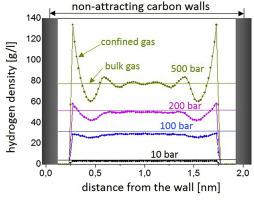Microporous and Mesoporous Materials ( IF 5.2 ) Pub Date : 2018-12-18 , DOI: 10.1016/j.micromeso.2018.12.024 Lucyna Firlej , Justyna Rogacka , Filip Formalik , Bogdan Kuchta

|
Unlike macroscopic objects, any system of nanometric size shows characteristics that strongly depend on its size and geometric form. It is mainly because the major part of atoms (or molecules) of nano-object is located at its surface, and their cohesive energy is smaller than for the atoms in the bulk. Here we show that when a fluid is confined in nano-volume, delimited by non-attractive pore walls, its density is heterogeneous, in particular close to the pore wall, and, on average, smaller than the density of bulk fluid. This effect progressively weakens when the pore size increases, and totally disappears for pores larger than 5 nm. The reported observation has non-trivial influence on evaluation of total and excess amount of fluid adsorbed in nanopores, as these quantities are traditionally calculated assuming the known – and homogeneous –density of the bulk fluid. Additionally, we propose a new method of the estimations of the accessible pore volume, based on the analysis of the density of confined fluid. The right estimation of both: pore volume and gas density is essential for quantitative interpretation of experimental adsorption isotherms: evaluation of pore size distribution and of the adsorbed amount. Although we analyze these problems taking an example of hydrogen at 77 K, our conclusions are general and apply to any fluid confined in nanopores.
中文翻译:

纳米孔中吸附的气体有多密?
与宏观物体不同,任何纳米尺寸的系统都具有强烈依赖其尺寸和几何形状的特征。这主要是因为纳米物体的原子(或分子)的主要部分位于其表面,并且它们的内聚能小于整体中原子的内聚能。在这里,我们表明,当流体被限制在纳米体积内(由无吸引力的孔壁界定)时,其密度是不均匀的,特别是靠近孔壁,并且平均而言小于散装流体的密度。当孔径增加时,该作用逐渐减弱,对于大于5 nm的孔,该作用完全消失。所报告的观察结果对纳米孔中吸附的液体总量和过剩量的评估具有重要影响,因为这些量传统上是在假定大体积流体已知密度和均匀密度的情况下计算的。此外,我们基于对密闭流体密度的分析,提出了一种估算可及孔隙体积的新方法。两者的正确估算:孔体积和气体密度对于定量解释实验吸附等温线至关重要:评估孔径分布和吸附量。尽管我们以77 K的氢为例分析了这些问题,但我们的结论是笼统的,适用于任何限制在纳米孔中的流体。孔体积和气体密度对于定量解释实验吸附等温线至关重要:评估孔径分布和吸附量。尽管我们以77 K的氢为例分析了这些问题,但我们的结论是笼统的,适用于任何限制在纳米孔中的流体。孔体积和气体密度对于定量解释实验吸附等温线至关重要:评估孔径分布和吸附量。尽管我们以77 K的氢为例分析了这些问题,但我们的结论是笼统的,适用于任何限制在纳米孔中的流体。


























 京公网安备 11010802027423号
京公网安备 11010802027423号